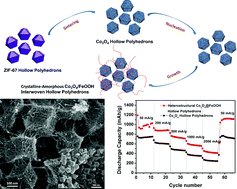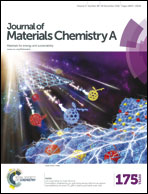Interwoven heterostructural Co3O4–carbon@FeOOH hollow polyhedrons with improved electrochemical performance†
Abstract
Complex heterostructured nanomaterials receive tremendous attention due to their superior physical and chemical performances than single-structured materials. Nevertheless, it remains a great challenge to precisely control the composition (crystalline or amorphous), size and dimension of the building blocks of hierarchical nanostructures. Herein, we report a scalable method for fabricating crystalline–Co3O4–carbon@amorphous-FeOOH interwoven hollow polyhedrons through thermal treatment paired with solution-phase growth for application as anodes in new-generation lithium ion batteries. In this synthesis, well-defined Co3O4–carbon hollow polyhedrons serve as both oxidizing agent and growth platform for amorphous FeOOH nanowires. The obtained heterostructured hollow polyhedrons exhibit a high reversible capacity of 603 mA h g−1 after 100 cycles at the specific current of 200 mA g−1, showing a capacity fading of only 0.158% per cycle between 10 to 100 cycles, much lower than that of pure Co3O4–carbon hollow polyhedrons (0.604%). When the specific current returns from 2000 mA g−1 to 50 mA g−1, Co3O4–carbon@FeOOH heterostructure maintains a specific capacity of 1120 mA h g−1, demonstrating remarkable cycleability and high rate capability. Such superior performance is attributed to the synergistic effect of integrated crystal and amorphous components as well as the unique interwoven heterostructure. The design of such an interwoven 3D frame architecture provides a new opportunity for obtaining high-performance electrode materials in the field of energy storage.


 Please wait while we load your content...
Please wait while we load your content...